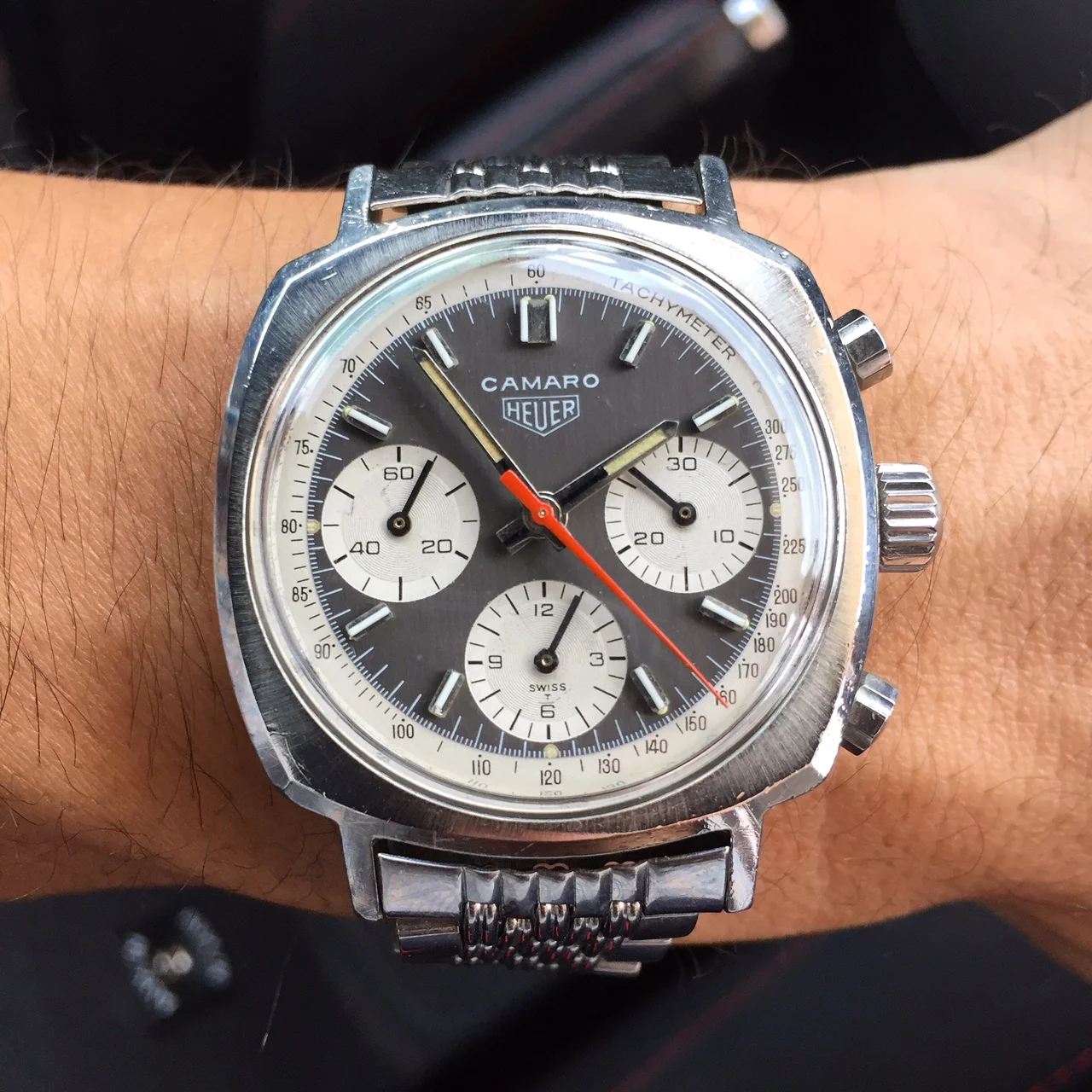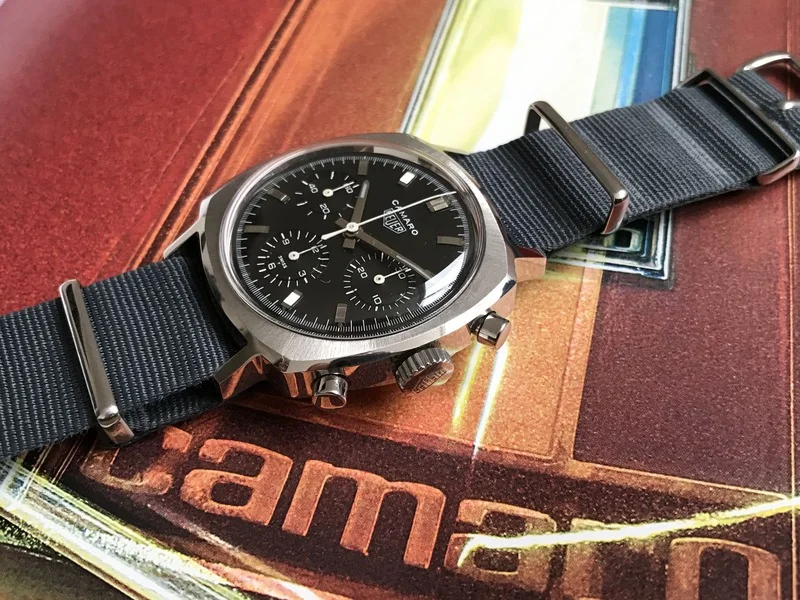Early Summer 2017 Vintage Watch Market Ramblings
I've often heard there is a vintage watch "season" or "seasons" where most of the action takes place in the spring and fall, in between holidays and summer vacations. I suppose this makes sense, as people are less busy, they're in their typical routines, and may be close to home more. The big auctions seem to follow this pattern as well, so maybe it's just that the buzz from those previews and results tends to drum up interest and chatter.
I don't know about the "seasons" but the less common variants or even the really good watches all seem to come in batches. Long at the top of my list have been a Heuer Camaro and a vintage Omega Speedmaster, so I tend to keep fairly good tabs on what's out there, and currently there is a relative abundance of Heuer Camaros (and Carreras) and pre-moon (straight-lug) Omega Speedmasters on the market at strong prices. There are certainly others as well (I feel like I've seen quite a few vintage Rolex Daytonas pop up recently), but I notice trends in these the most since I track them the most consistently.
Using the often neglected, stepsister of sorts to the Carrera and Autavia, Heuer Camaro as an example, we can go months at a time without seeing one worth discussing come up for sale, and there have been 3-5 in the last week, and more in the last month. We also saw Camaros featured in nearly all of the spring auctions. In the past few years, it was surprising to see even one. Prices for the Camaros are also being pulled up with many in the $7,000 - $10,000 range at auction, and even a few (exceptional) private sales (asking) that amount.
What does this mean?
I don't want to get too deep in the weeds here, as there are so many out there with more experience, but the typical discussions have the same themes. Some will throw out that it's a bubble and people are just going mad for popular or hot vintage watches that are getting their day in the sun. Someone then typically points out that a "bubble" implies that prices will go down from their current highs. Well, what drives prices down? Either a sudden drop of interest or an abundance of supply, and neither show any signs of occurring, particularly an increase in supply since we are dealing with vintage watches.
The other theme tends to be that a rising tide lifts all ships. As prices for the top (most sought after/rare/coveted) vintage chronographs continue to increase, people will link similar pieces to those, and less expensive options gain more competition. Using a brand like Heuer as an example again, as more and more interest for the Autavia and Carrera develops, collectors develop an increased awareness of their other watches, driving demand for something like the Camaro.
For the typical collector that has "their list", this means it just gets harder (more expensive) to check the next one off. It's kind of unfortunate and a sinking feeling many have knowing that a watch they had a chance to buy two years ago at $4,500 is now $8,000, but I suppose the inverse is that if they did buy something else on their list two years ago, it might have experienced the same appreciation. For the new collector, this makes the price of entry a bigger barrier, but knowing the supply is not going to increase should help ensure a smart buy shouldn't hurt. And by "smart buy" I mean a well vetted, correct, and honest, watch in good condition; these are the watches that keep good. This is starting to turn a bit more "investment" sided, so please don't get the wrong impression, as you will see discussed in any watch collecting circle, you should always buy what you love, and not buy for investment purposes. This ensures the watches will always have "value".
Where do we go from here?
For those on your list that continue to rise, I say the only thing you can do is continue to be in tune with the market so you can identify the "right" or at least a good watch at a fair price. Try and buy the best condition watches possible, and buy what you love. Anytime we see watches in time-capsule preserved like condition go for strong prices, lesser examples seem to come out of the woodwork hoping to ride their coattails upwards. The watches in the best condition or even good, honest condition, will always fetch the best prices, especially as they continue to get older.
Another option is to turn to alternatives. Most vintage watches were made from parts sourced from a variety of manufacturers, so there is typically a lot of similarity in appearance, case, dial, hands, movement, etc., across many brands. So, you can often times find something with many of the same characteristics under a different brand for less. Kind of like the "poor man's" watches, I've often feature in the sub register. My no-name Heteca Durexact is a good example of this: found discarded in a thrift shop, it has drilled and chamfered lugs, big sub registers, Dauphine hands, applied indices, and a Valjoux 72 movement the same as many of the most sought after vintage chronographs but cost / is worth a mere fraction of the big boys.
Seeking out the next batch of "vintage" watches is another path that could pan out. This takes more speculation to identify the future classics, but as I've mentioned here before, neo-vintage watches represent a lot of "value" these days. By neo-vintage, I'm particularly referring to early to mid 1990's watches with the last of the tritium dials. These watches still sound too new to most, but being that most are approaching their late 20's and they are the last watches to use tritium lume, they have plenty of time to develop patina of their own in the years to come. Looking at 1990's Tudor Subs, Omega Speedmasters, and Rolex Explorer II's as examples, these are all (presumably) about as cheap as their going to get, and they all have the opportunity to develop a vintage charm and patina, if they haven't already.
What does this have to do with anything?
If you're still reading, I'm not sure. I started this week like the other sub register features, just trying to find some fun watches, and by typing away ended up here. I guess part of this is aimed at those that may not be in as deep and are trying to get a feel for these things, part is just my ramblings on how the vintage market continues to tick upwards, despite that this conversation has been had for the last 4-5 years, and part is simply that with that continued strength comes additional competition, and it's just getting harder to find those fun options consistently.
I am certainly no expert and just an enthusiastic hobbyist and wannabe collector, but I like to think I am starting to understand what little can be understood about this crazy game, and have made some (hopefully) decent decisions thus far, while continuing to learn from any mistakes. One of the most common adages is to buy what you know and that sentiment only continues to gain importance. The watches put out 50 years ago were just so good, and demand and appreciation seems to only be growing.
Good luck on your hunting, be smart, and chime in below with your thoughts, reactions, and $0.02. Thanks for reading.





